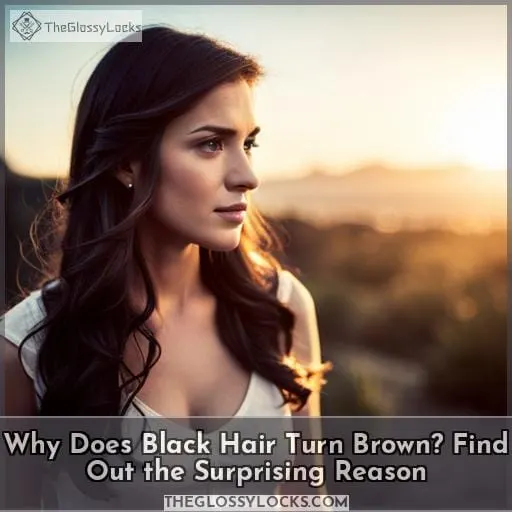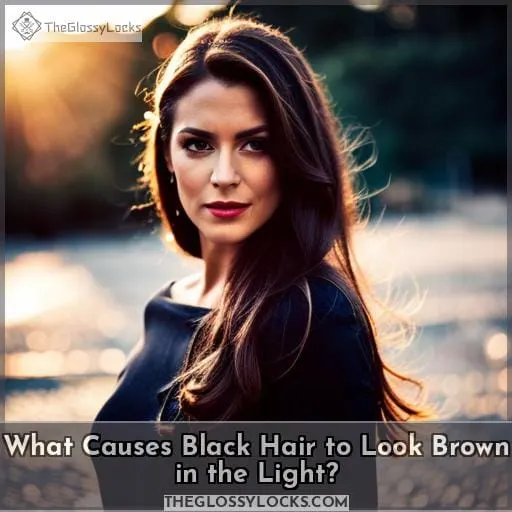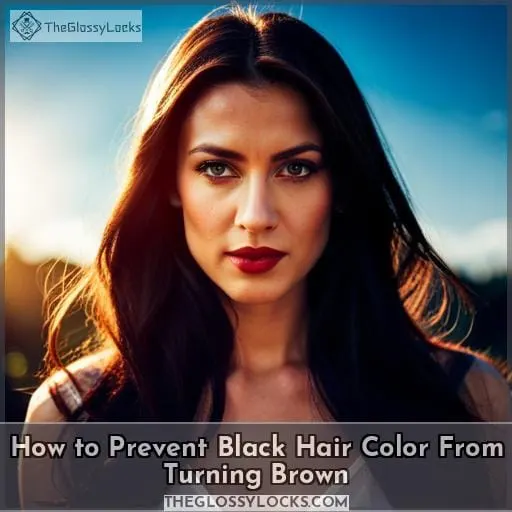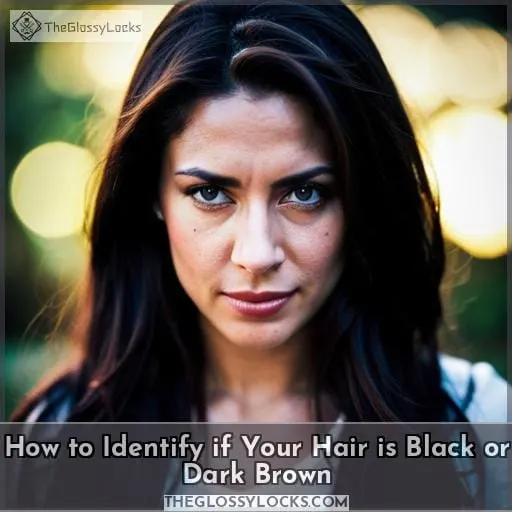This site is supported by our readers. We may earn a commission, at no cost to you, if you purchase through links.
 Have you ever noticed that your black hair looks brown in the light? It’s a common phenomenon, and it has a surprisingly scientific explanation. In this article, we’ll discuss why does my black hair look brown in the light and how to prevent it from happening.
Have you ever noticed that your black hair looks brown in the light? It’s a common phenomenon, and it has a surprisingly scientific explanation. In this article, we’ll discuss why does my black hair look brown in the light and how to prevent it from happening.
We’ll also cover identifying whether your hair is actually black or dark brown as well as the pros and cons of dyeing your locks jet-black.
So let’s get started uncovering why our manes can change hues!
Table Of Contents
- Key Takeaways
- What Causes Black Hair to Look Brown in the Light?
- How to Prevent Black Hair Color From Turning Brown
- How to Identify if Your Hair is Black or Dark Brown
- The Pros and Cons of Dyed Black Hair
- Top 3 Hair Color Products to Achieve Black Hair
- Why Does Black Hair Look Red in the Sunlight?
- 5 Tips to Prevent Premature Browning of Black Hair
- Conclusion
Key Takeaways
- Sunlight exposure breaks down melanin particles in black hair, causing it to appear brown over time.
- Genetics play a significant role in determining the natural hue of black hair and the ratio of pigments, which affects color retention.
- Washing black hair with hard water may lead to mineral deposits, resulting in a change in hair color.
- To maintain black hair color, use UV-protective products, wash hair with lukewarm water, and consider weekly protein masks to strengthen hair against environmental damage.
What Causes Black Hair to Look Brown in the Light?
Unlock the secret to maintaining that lustrous black hair color for longer, even when exposed to sunlight! Sunlight is a major factor in the discoloration of dark hair.
Hair pigments are made up of melanin and eumelanin, which interact with lighting conditions differently. When exposed to direct or indirect sunlight, the melanin particles break down. This causes some types of black hair dyeing products, such as jet-black dyes and henna treatments, to turn brown over time.
The intensity and duration of sun exposure play an important role in how quickly your tresses may change hue from deep ebony locks into light chestnut hues.
To prevent premature discoloration, seek professional advice on protecting your mane from harmful UV rays. You can use protective accessories like scarves or hats while outdoors. Additionally, washing your hair with lukewarm temperatures can help retain its natural color.
If necessary, you can boil hard water sources beforehand to avoid mineral deposits.
Making use of weekly protein masks can further strengthen strands against environmental damage.
How to Prevent Black Hair Color From Turning Brown
Preserving black hair color can be difficult in sunlight, especially when using hard water to wash. Genetics and hormonal changes also play a role in determining the natural color of one’s hair. To prevent premature change, it is important to shield the hair from direct sunlight with coverings such as umbrellas or scarves, use lukewarm water for washing instead of hot baths, and opt for natural alternatives like henna rather than chemical dyes.
Protecting Hair From Sunlight
You can keep your hair color looking vibrant by protecting it from the sun’s rays. Try using a light, UV-protective spray or cream to shield your hair from sunlight and heat damage. If you’re going outside, cover up with an umbrella or hat for maximum protection.
To prevent brown undertones from forming due to the reflection of sunlight off lighter hairs on top of dark ones, try tinting those strands black as well. Avoid washing with hard water, which contains minerals that may make the melanin in your hair fade faster than usual.
Instead, opt for lukewarm water when rinsing out products like shampoo and conditioner after use.
Avoiding Washing With Hard Water
To reduce the chances of your black hair turning brown in the light, avoid washing with hard water as it can contain mineral deposits that damage hair color. Studies have found that up to 85% of Americans are supplied by hard water systems.
Here are five tips for maintaining healthy hair while using a hard water system:
- Use lukewarm showers instead of hot ones.
- Protect your hair from mineral deposits by rinsing with white vinegar.
- Shield your hair from direct sunlight and cover it with a hat or scarf.
- Prefer natural alternatives like henna over jet black dyes.
- Strengthen your locks with protein masks and leave-in conditioners.
Pay attention to how you wash your hair – choose quality products, monitor the effects on color, and consult professionals if necessary!
Genetic Factors and Hair Color
Take control of your hair color destiny! Genetics play a major role in determining the natural hue and shade of your tresses. Hair pigments are produced by melanocytes located in the hair follicles, which respond to genetic factors like eumelanin and pheomelanin.
This influences how much sunlight exposure is required for a shift from dark brown to light brown or even blonde tones.
To prevent premature discoloration, you should strengthen your strands with conditioners, masks, and products free from ammonia or mineral deposits that may cause damage over time. If you have naturally dark locks, it’s important to identify the true color at the root level so as not to over-process it when dyeing.
How to Identify if Your Hair is Black or Dark Brown
Identifying if your hair is black or dark brown may be difficult since the shades look quite similar and can appear different under certain lighting. To determine your underlying hair color, it helps to examine how light affects its appearance.
When exposed to direct sunlight, black hair can often appear lighter due to melanin pigments that naturally occur in darker strands. The same applies for dark brown hues; they too will likely look more vibrant when hit by natural lighting as opposed to artificial indoor illumination.
When identifying which shade of color you have, here are some tips:
- Look at Your Roots: A good indicator of true pigment lies within the roots and how much contrast exists between them and bleached ends.
- Consider Lighting Effects: Natural outdoor light has a tendency of making colors brighter while fluorescent lights tend to make everything duller.
- Assess Color Perception Under Various Conditions: Examine whether there’s any difference in hue depending on time spent outdoors versus indoors during the day.
- Take Note Of Hair Pigmentation: Pay attention to differences between natural shades versus dyed ones – this could give insight into what level of darkness/lightness you’re dealing with overall.
Ultimately, understanding both methods will help ensure that your true identity shines through no matter what type or style of lighting is present!
The Pros and Cons of Dyed Black Hair
Looking to get the perfect shade of black hair? Dyeing your hair can be a great way to achieve that, but it comes with its own set of pros and cons. From increasing shine and giving an intense color payoff to needing more maintenance than other shades, dyed black hair has its own unique considerations.
Pros of Dyed Black Hair
Benefit from the bold, vibrant look of dyed black hair without worrying about it fading in sunlight. You can maintain your color for longer with a permanent dye and enjoy its deep hue outdoors while protecting it with an umbrella or coverings.
Sun exposure will lighten naturally dark hair but not affect dyed locks as long as they are properly maintained. It’s important to consult a professional to identify your true hair color from the roots before applying any product, as genetics influence pheomelanin production which is responsible for red tones.
To strengthen weakened strands caused by dying procedures, you can use hair masks and natural products. This will make your hair more resistant to sun damage. By taking care of your newly-dyed tresses, you can enjoy beautiful results that last without facing premature discoloration.
Cons of Dyed Black Hair
However, dyed black hair can be prone to premature color change in the sun, which could require more frequent touch-ups for maintenance. Hair dyes contain chemicals that may damage or dry out hair strands and cause irritation on scalps.
Additionally, jet black dye is known to fade quickly when exposed to sunlight over time compared with other shades of permanent dye such as blonde or brown.
Furthermore, semi-permanent dyes are not recommended for use on dark-colored hairs because they often don’t offer good coverage and can lead to premature graying of the hair strands due to their lack of resistance against UV radiation from sunlight.
Professional advice should be taken into consideration before selecting any type of dyeing product as it might result in undesired results if used improperly without understanding what effects different products will have on your particular kind of hair structure and texture.
Top 3 Hair Color Products to Achieve Black Hair
Achieving a black hair look that appears brown in the light can be accomplished with a variety of products and techniques. The Adore Haircolor Jet Black 3 Pack, Wella Colorcharm Demi Blonde, and L’Oreal Paris Excellence Hicolor Black Onyx offer permanent dyeing results that are long-lasting and fade-resistant.
With these top three color products, you will achieve a true-to-tone result for your desired look.
Adore Haircolor Jet Black 3 Pack
Discover the vibrant and long-lasting color of Adore Haircolor Jet Black 3 Pack, a semi-permanent dye made in the USA without alcohol, peroxide, or ammonia.
This product offers great gray coverage for first-time users, but some customers have had issues with color retention. Protect your dark locks from sun exposure to maintain their deep pigments by using lukewarm water and natural products like henna instead of harsh chemicals.
With proper maintenance techniques, such as weekly protein masks or applying sunscreen on days spent outdoors, paired with appropriate shade selection that complements your skin tone, achieving beautiful black hair is possible!
Wella Colorcharm Demi Blonde
Experience true-to-tone color results and excellent gray coverage with Wella Colorcharm Demi Blonde. This 10A Palest Ash Blonde gel offers long-lasting, fade-resistant color that is specifically designed for first-time users.
Mix the product with Oreor Crème Developer 30 volume (20 for relaxed hair) and enjoy no itchy scalp caused by a strong scent, but a lasting result after 30 minutes of processing at room temperature.
Customers praise its ability to mix well with other colors in the line. However, some have had issues regarding tampering on delivery.
To protect black hair from the effects of sunlight, use a leave-in conditioner or scarves when outdoors. It is also recommended to avoid hot head baths, as high body temperatures can strip away dye faster than usual.
Loreal Paris Excellence Hicolor Black Onyx
Unlock the beauty of dark hair with L’Oréal Paris Excellence HiColor, designed specifically for relaxed textured hair. It offers three Violet shades and three Black Onyx shades, providing true-to-tone color results.
Mixed with Oreor Crème Developer 30 volume (20 volume for relaxed hair), it covers even gray hairs in just 30 minutes at room temperature.
Tips to retain its rich black hue include using sunscreen, avoiding hard water washing, strengthening the strands with protein masks or natural products like vinegar, and covering up when outdoors.
This product is a must-have that will give your locks an intense boost of long-lasting color without any unpleasant odors or red tinting on dark hues!
Why Does Black Hair Look Red in the Sunlight?
Feel the impact of sunlight on your black hair as it reveals hints of red pigment in its depths. This color shift is caused by the interaction between melanin and sunlight, which alters how light reflects off each individual strand.
Melanin absorbs certain wavelengths while reflecting others, causing a reddish hue to appear when hit with direct sunlight. The amount of melanin present in one’s hair determines how much influence this phenomenon will have on an individual’s overall look.
Possessing more eumelanin than pheomelanin naturally darkens locks but can still result in sun-induced color shifts if exposure is too frequent or intense.
To prevent premature changes from occurring over time due to UV rays, consider using protective measures such as scarves and sunscreen for your strands before heading outdoors into bright daylight conditions!
5 Tips to Prevent Premature Browning of Black Hair
Protecting your black hair from premature browning can be tricky, but with the right combination of sun protection, mineral-free water, and proper care, it is possible. Genetics may also play a role in how well you retain color in your hair; however, there are steps you can take to maximize its longevity.
Protecting Hair From Sun Exposure
Protect your black hair from the sun to keep it looking vibrant and healthy! Shield it with an umbrella or a hat, as direct sunlight can reduce color intensity. Apply sunscreen specifically for hair before leaving home. Look for one that’s light in texture and not heavy on the scalp.
Hair coverings like scarves are also great options to protect your locks from UV rays while giving you an effortlessly chic look at the same time! If you’re swimming outdoors, don a swim cap or wet your tresses beforehand as chlorine may strip away natural oils in black hair, leading to premature browning.
For long-term protection against sunlight effects, choose ammonia-free products that help retain color without damaging strands further.
Avoiding Hard Water Minerals
Shield your hair from hard water minerals by using lukewarm, filtered water for washing. Protecting hair from mineral deposits is an essential step in maintaining color and preventing premature browning.
Use a shower filter to reduce the amount of chlorine and other contaminants that can damage the natural proteins in strands, causing fading or discoloration.
To further safeguard your hair, choose shampoos specifically designed for colored hair. It’s also important to monitor the quality of your local tap water regularly. Before shampooing, test pH levels to protect against chemical imbalance.
Additionally, washing with vinegar-based solutions weekly can provide extra protection against murky waters.
Don’t let harsh minerals rob you of your desired shade – arm yourself with knowledge on how best to care for your hair!
Genetic Factors and Hair Color Retention
Genetics can play a major role in how your hair color is retained, so understanding the genetic factors that influence it could help you keep dark hair looking vibrant for longer.
Eumelanin and pheomelanin are two pigments responsible for giving black hair its deep hue. Genetics play a significant role in determining the ratio of these pigments, which affects the longevity of natural or dyed black hair.
Sunlight also impacts melanocytes in follicles and causes them to create less pigment.
Consulting professionals, such as dermatologists, about changes to your hair can be beneficial too. They may suggest ways to protect your hair from the effects of sunlight, such as using sunscreen on your tresses or covering up with an umbrella when outdoors.
Conclusion
To sum it up, black hair can look brown in the light due to a combination of sunlight exposure, hard water, and genetics. Protective sun coverings, lukewarm water, protein masks, and ammonia-free products can help maintain black hair color.
It’s wise to identify the true hair color from the roots and seek professional advice if needed.
Popular products that can help achieve the desired black hair look include Adore Haircolor Jet Black 3 Pack, Wella Colorcharm Demi Blonde, and Loreal Paris Excellence Hicolor Black Onyx. While there are pros and cons of dyed black hair, understanding the underlying causes of why black hair looks brown in the light and how to prevent it from happening can help achieve long-lasting black hair.






